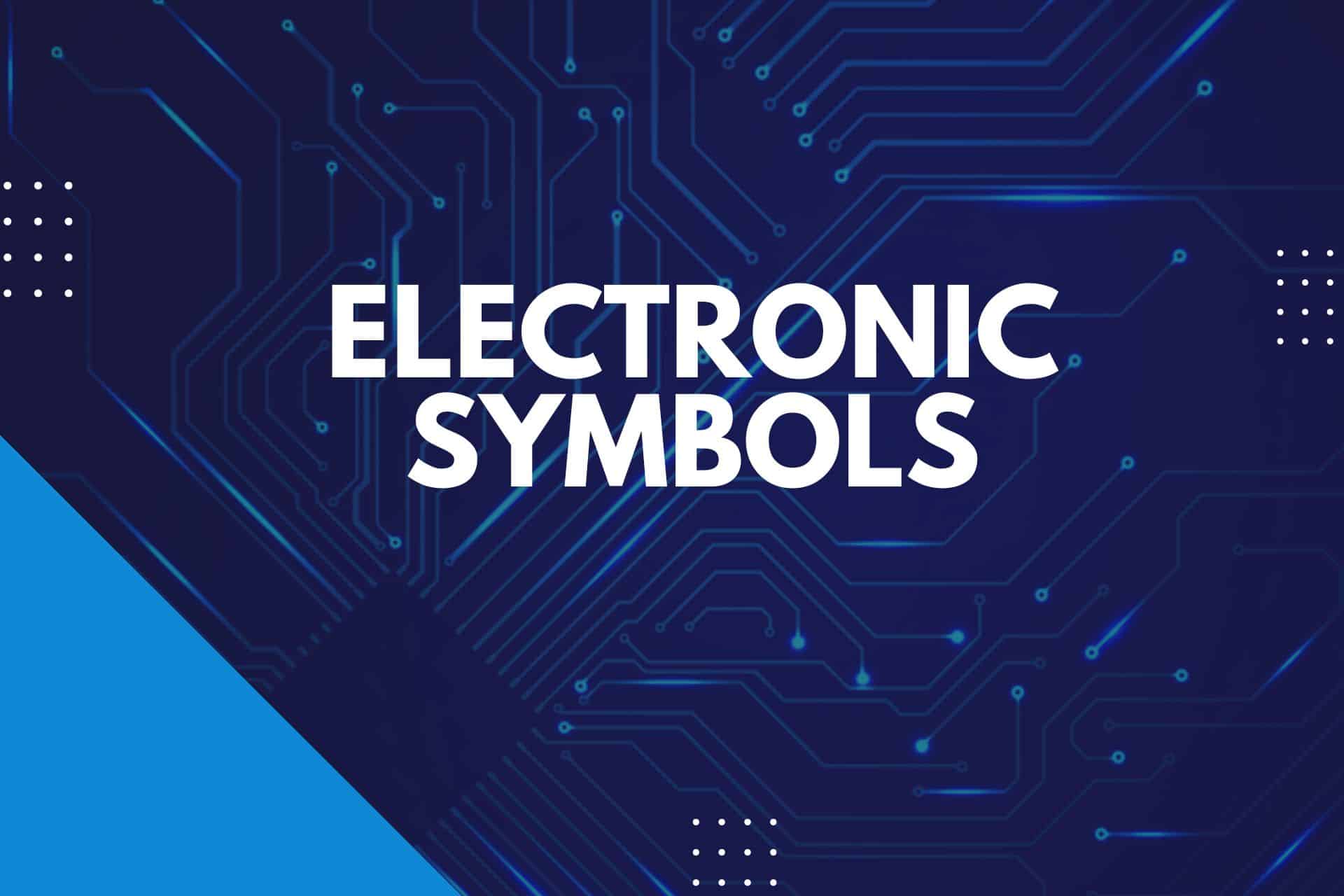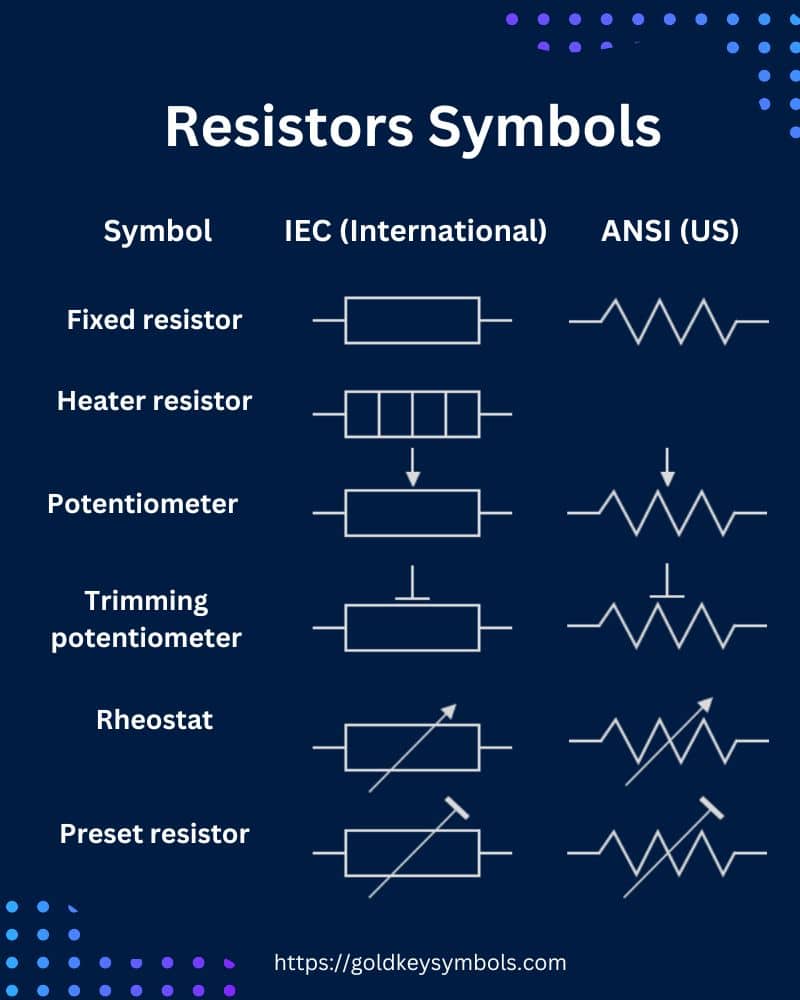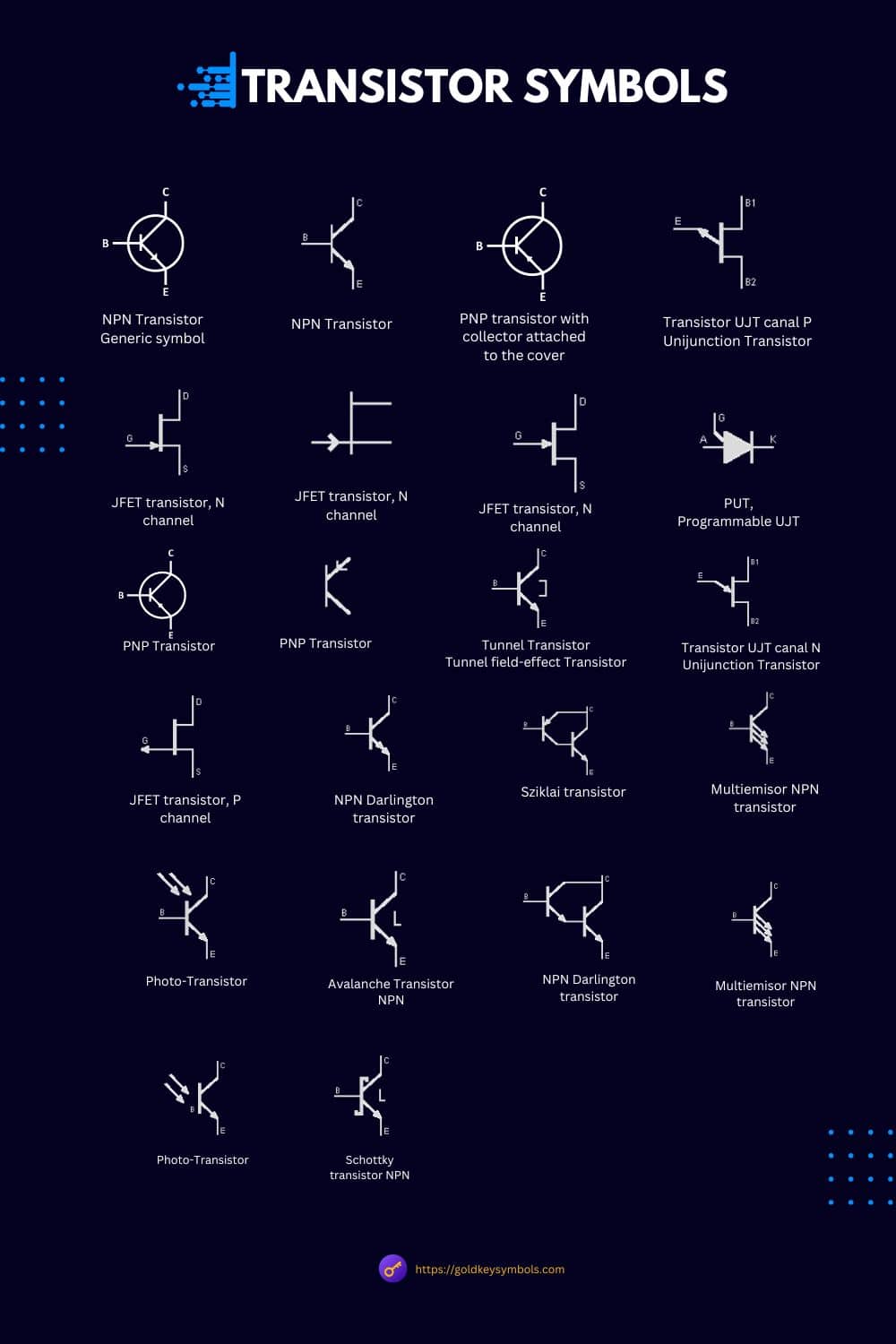The Ultimate Guide to Mastering the Circuitry of the Future!
Are you fascinated by electronics but feel lost in the maze of electronic symbols?
This article demystifies electronic symbols, offering a clear overview of their history, significance, and how they serve as the building blocks of all electronic schematics.
By exploring the rich tapestry of symbols used in electronics, you’ll gain knowledge and the confidence to engage with technology more deeply.
Continue reading to learn more about the fascinating world of electronic and electrical symbols and how they shape the technology around us.
Let’s get started!

Here’s What You Will Find

Key Takeaways
Electronic Symbols
Diverse Range of Symbols: The article highlights the vast array of symbols used in electronic schematics, each representing different components like resistors, capacitors, diodes, and various types of ICs. These symbols are essential for understanding and designing electronic circuits, acting as a universal language for engineers and enthusiasts.
Functional Categories of Components: Electronic components are categorized based on functionality—passive components like resistors and capacitors that store or regulate energy without amplification, and active components like transistors and ICs that can control current flow and amplify signals.
Importance of Integrated Circuits: Integrated Circuits (ICs), both analog and digital, form the backbone of modern electronics. The article discusses various types of ICs, including operational amplifiers, voltage regulators, and microcontrollers, each serving specific functions in electronic devices.
Role in Technology and Design: Understanding these symbols and their corresponding components is crucial for anyone involved in electronics, from simple circuit troubleshooting to complex system design. This knowledge not only aids in the practical assembly and maintenance of electronic devices but also fosters innovation and creativity in technology development.
What are Electronic Symbols?
Electronic component symbols are the basic building blocks of electronic schematics, with diagrams depicting electronic circuits’ components and connections.
Electronic symbols represent physical components, such as resistors, capacitors, transistors, and diodes, in a simplified and standardized form. Their primary function is communicating complex electronic designs and circuitry clearly and concisely, making them indispensable tools in electronics engineering and design.
The significance of electronic symbols extends beyond mere representation. They serve as a universal language that allows engineers, technicians, and hobbyists worldwide to understand and construct electronic circuits without needing detailed verbal explanations. This universal language is crucial for designing, testing, troubleshooting, and maintaining electronic devices and systems.
Using standardized symbols, individuals and teams can collaborate on electronic designs, share ideas, and ensure consistency and accuracy across various projects and applications.
Organizations Regulating Electronic Symbols
Electronic symbols are governed by standards set by the Institute of Electrical and Electronics Engineers (IEEE) and the International Electrotechnical Commission (IEC).
These standards ensure uniformity and clarity across the globe, making it possible for electronic diagrams to be universally understood despite geographical and language barriers. The IEEE Standard 315 and the IEC 60617 are two documents that provide a comprehensive list of electronic symbols and their definitions.
Adherence to these standards is essential for effectively communicating electronic concepts and successfully implementing electronic circuits and systems.
Other Names
Electronic symbols are known by various terms across different regions and contexts, highlighting electronics’ diverse applications and global nature. In some cases, these symbols are referred to according to the type of diagram they are used in or their specific application.
One of the most common alternative terms for electronic symbols is “schematic symbols.” This term emphasizes using these symbols in schematic diagrams and detailed representations of electronic circuits. Schematic diagrams, and thus schematic symbols, are essential for visualizing the components of a circuit and their connections in a structured and simplified manner.
Other terms may include “schematic symbols,” “circuit symbols,” or “electrical symbols,” especially when discussing the broader context of electrical engineering. These terminology variations reflect electronic symbols’ versatile applications, from designing tiny integrated circuits to mapping out complex electrical systems.
Regardless of the term used, the fundamental purpose remains: to provide a standardized visual language that facilitates the understanding, design, construction, and analysis of electronic circuits.
Deciphering these electronic circuits symbols is a foundational skill for anyone involved in electronics. It bridges language gaps and ensures effective communication within the global electronics community.
The Importance of Electronic Symbols in Circuit Design
Electronic symbols are essential in circuit design. They clearly and concisely represent the components and connections that make up an electronic system. This visual shorthand allows engineers and designers to convey complex information in an accessible format, facilitating understanding, collaboration, and innovation.
From schematic diagrams to real-world applications, electronic symbols bridge concept and creation. They enable the visualization of electrical and electronic systems before they are built, allowing for planning, analysis, and optimization.
Moreover, these symbols are crucial in troubleshooting and repairs, offering a roadmap to understanding and diagnosing issues within electronic devices.
What is the Purpose of Symbols in Circuit Design?
In circuit design, symbols serve as representations and a language that promotes efficiency and accuracy.
By adhering to standardized electrical and electronic circuit symbols, designers ensure that their schematics can be understood and implemented globally, transcending language barriers and fostering international collaboration.
What are standard circuit symbols?
Standard circuit symbols are universally recognized graphical representations of electrical and electronic components used in circuit diagrams. They serve as the shorthand language for engineers, technicians, and others who design, construct, and analyze electrical and electronic circuits.
By adhering to a set of standardized symbols, anyone can understand a circuit’s components and layout without needing detailed verbal descriptions. This facilitates global communication and collaboration in the field of electronics.
Various international and national organizations govern the standardization of circuit symbols, which ensures consistency and clarity across regions and industries.
The Institute of Electrical and Electronics Engineers (IEEE) and the International Electrotechnical Commission (IEC) are two prominent bodies that publish standards for circuit symbols. For example, the IEEE Std 315-1975 (Reaffirmed 1993) and the IEC 60617 series set standardized symbols for various electrical and electronic components.
Types of Electronic Symbols
In the intricate world of electronics, the vast array of components that breathe life into devices, systems, and machinery is represented through universally recognized symbols. These symbols are the essential language of electronic schematics, enabling engineers, technicians, and enthusiasts to communicate complex ideas and designs with clarity and precision.
Each symbol encapsulates a specific function integral to electronic circuits ‘ operation, from the active components that amplify and control electrical signals to the passive elements that resist, store, and filter.
Power sources provide the essential energy, while integrated circuits combine sophistication and functionality in miniature form.
Connectors and interfaces bridge components, facilitating interaction and integration within and between devices. As we explore the categories of electronic symbols, we uncover the building blocks of technology, each revealing the components’ roles and how they interconnect to form the complex tapestry of modern electronics.
This exploration highlights the diversity of electronic symbols and emphasizes their significance in creating, understanding, and advancing electronic technology.
Active Components Symbols
Active components are vital in electronics because they amplify signals, control current flow, and perform logic operations. They rely on an external power source to function and are essential in processing and managing electronic signals.
Transistors
Transistors, the building blocks of modern electronics, are represented by symbols that vary slightly for NPN and PNP types. These symbols reflect the transistor’s operation as switches or amplifiers. They encapsulate the transistor’s function in controlling a large current flow with a smaller one, a principle that underpins amplification and switching.
Serve as the backbone of both digital and analog circuits, playing roles from switching and amplifying signals to processing complex computations. They are essential for the dynamic control of electronic circuits.
Diodes
Diodes are symbolized by a triangle pointing towards a line, embodying the directionality of these components that allow current to flow in only one direction. They are essential for rectification, signal modulation, and protection circuits against voltage spikes.
These components, specialized in directing current flow, are crucial for signal rectification, voltage regulation, and light emission, offering protection and control within electronic systems.
Integrated Circuits (ICs)
Integrated Circuits (ICs), depicted as rectangles with various inputs and outputs, are the brains behind most modern electronics. These symbols often include details of pin configurations but abstract the complex internal functionality into a simple box, highlighting the IC’s role as a miniaturized circuit of transistors and other components performing specific functions.
The brains behind modern electronics integrate numerous transistors and other components into a single package to perform various functions, from simple logic operations to complex computing tasks.
Silicon-Controlled Rectifiers (SCRs)
Key in power control, SCRs, and other thyristors switch and manage high power levels efficiently, pivotal in applications requiring precise control over voltage and current.
Passive Components Symbols
Passive components do not require an external power source and play foundational roles in filtering, storing energy, and establishing circuits’ essential functionality.
Resistors
A resistor, symbolized by a series of jagged lines, plays a critical role in controlling the flow of electrical current within a circuit. Its primary function is to provide resistance, which controls the voltage and current according to Ohm’s Law.
Resistors help control current flow and voltage levels within circuits by managing signal levels, dividing voltages, and limiting current.
Capacitors
Capacitors, depicted as two parallel lines with a gap between them, store electrical energy in an electric field. They are crucial in filtering out noise, stabilizing voltages, and storing energy for later use. The symbol’s simplicity belies the capacitor’s role in timing circuits, oscillators, and various forms of electronic conditioning.
They store and release electrical energy, playing critical roles in filtering, power smoothing, and timing applications. They are essential for managing signal integrity and power supply stability.
Inductors
Inductors, represented by a series of loops or a coil, store energy in a magnetic field when electric current flows through them. They are fundamental in circuits that filter signals, block changes in current, and are integral to transformers and tuned circuits. The coil symbol captures the essence of inductance, embodying the physics of electromagnetic induction in a straightforward design.
Inductors store energy in a magnetic field, which is crucial for filtering, energy storage, and resonant circuits. Inductors help manage signal frequencies and protect against surges.
Power Sources Symbols
Power sources provide the essential energy for electronic circuits, ranging from portable devices to large-scale power systems.
Batteries
Battery and power supply symbols are straightforward. Batteries are typically represented by alternating long and short lines indicating the positive and negative terminals.
Batteries offer portable power solutions in various chemistries, including alkaline, lithium-ion, and lead-acid, which are crucial for mobile devices and backup power systems.
Power Supplies
Power supplies, meanwhile, may be symbolized by a circle with an AC (alternating current) or DC (direct current) designation, depending on the source. These symbols are the starting points in a circuit diagram, indicating where the power originates.
Power supplies convert and regulate power from the mains or other sources into usable forms for electronic devices, ensuring stable and reliable operation across various applications.
Integrated Circuits (ICs) Symbols
Integrated circuits encapsulate complex functionalities into compact packages. They are categorized into analog and digital domains for processing diverse signal types.
Analog ICs
Include components like operational amplifiers and voltage regulators, which are fundamental in signal amplification, conditioning, and power management.
Digital Logic ICs
Comprise logic gates and memory elements, forming the basis of digital computing and data processing systems, are essential for implementing logical operations and storing information.
Grounds, Connectors, and Interfaces Symbols
Connections are often shown as dots where wires intersect, clarifying the points at which components are electrically connected.
Connectors and interfaces ensure reliable physical and electrical connections between different parts of an electronic system, facilitating communication and power transfer.
Grounds
Ground symbols vary but commonly include lines that fan out downwards, symbolizing the electrical circuit’s return path to the earth or a common reference point in a circuit.
Jacks and Plugs
Include audio, USB, and HDMI connectors, enabling multimedia, data, and power interfacing between devices.
Switches and Relays
Switches are depicted in various forms, indicating their function, from turning circuits on and off to selecting between different circuit paths.
Comprise devices for making or breaking electrical connections and controlling current flow through circuits based on specific conditions or inputs.
Communication and Display Symbols
These categories encompass components and modules specialized in sensing, communication, and display functionalities, integrating modern electronics into a cohesive system.
Sensors and Transducers
Detect and measure physical quantities, converting them into electrical signals for monitoring and control.
Communication Modules
Enable wireless and wired communication capabilities for interconnected and smart device functionalities.
Display and Indication Symbols
Visual components that provide user interfaces and feedback critical for interaction with electronic devices and systems.
Meaning Behind the Electronic Symbols
The design of electronic symbols is not arbitrary; it often involves significant logic and reasoning that reflect the physical characteristics or functionality of the components they represent.
This thoughtful design helps us intuitively understand a component’s role within a circuit, even before exploring its specific technical details.
Let’s explore the rationale behind the shapes and designs of some common circuit symbols of electronic components and their functions and how these designs relate to the components’ physical or functional aspects.
Resistor
The symbol for a resistor is a zigzag line. This design intuitively represents its primary function: impeding the flow of electric current, creating resistance in the circuit.

The zigzag pattern can be considered a path that forces the electrons to take a more challenging route, symbolizing the resistance process. In physical terms, resistors can have a coiled wire or a composition that forces current to pass through a material that resists flow, much like the symbolic zigzag makes the current “zigzag” through the circuit.
Capacitor
Capacitors are represented by two parallel lines, sometimes with one line curved, facing each other. These lines symbolize the capacitor’s two conductive plates separated by an insulating material (dielectric).

This design straightforwardly reflects the physical structure of most capacitors. The gap between the lines symbolizes the dielectric barrier that stores energy as an electric field. The symbol’s simplicity helps identify the component in a circuit and quickly understand its role in storing and releasing electrical energy.
Diode
The symbol for a diode, a triangle pointing towards a line, encapsulates the diode’s one-way flow characteristic. The triangle acts like an arrow, indicating the direction in which current can flow (from the tip of the triangle to the line). In contrast, the line is a barrier for current trying to flow in the opposite direction.
This symbolism perfectly aligns with the diode’s purpose: allowing current to pass easily in one direction while blocking it in the other, akin to an electronic check valve.
Transistor
Transistors, the building blocks of modern electronic devices, have symbols that vary slightly depending on their type (e.g., NPN or PNP for bipolar junction transistors). Generally, a transistor symbol includes a circle or rectangle with three legs extending out, representing the three layers of semiconductor material and the three terminals (emitter, base, and collector).

The arrows on the emitter leg indicate the direction of current flow, which is crucial for understanding the transistor’s operation mode. The design subtly hints at the transistor’s ability to amplify or switch electronic signals, with the base acting as the control gate for current flowing between the collector and emitter.
Integrated Circuit (IC)
An integrated circuit symbol typically represents a rectangle with multiple legs extending from its sides, symbolizing the IC’s inputs and outputs.
This simple design abstractly reflects the complexity and functionality housed within the actual IC chip—a compact, multifunctional component capable of performing a vast array of electronic functions. The rectangle can be seen as the silicon chip, while the legs represent the pins that connect the IC to other components in the circuit.
Through these designs, electronic symbols bridge abstract circuit diagrams and the physical reality of electronic components. The logic behind each symbol’s shape and design aids in visualizing the component’s role and functionality within a circuit, enhancing the understanding and efficiency of electronic design and troubleshooting processes.
This connection between symbol and function simplifies the learning curve for newcomers and streamlines communication among seasoned professionals in electronics.
Uses of Electronic Symbols
Electronic symbols are integral to electronics and crucial in designing, analyzing, and understanding electronic circuits. They are used in many fields, from consumer electronics to automotive systems and industrial control mechanisms.
Electronic symbols offer a standardized visual language that facilitates the creation, interpretation, and troubleshooting of schematic diagrams and graphical representations of electronic circuits.
In Schematic Diagrams
Schematic diagrams, the primary application of electronic symbols, are akin to electronic blueprints. They detail the components of a circuit, their relationships, and how they are connected without focusing on the physical layout of the elements.
Each symbol in a schematic represents a specific electronic component, such as a resistor, capacitor, or integrated circuit, and is connected to other components via lines that represent electrical wires or traces.
Electronic symbols in schematic diagrams allow for a clear and concise depiction of complex circuits. This clarity is essential for several reasons:
- Design: Engineers and designers use schematic diagrams during the initial stages of electronic device development to map out circuit designs and functionalities.
- Analysis: By studying a schematic, engineers can understand the flow of current through a circuit, identify signal paths, and predict the behavior of the circuit under different conditions.
- Troubleshooting: Schematics are crucial for identifying circuit problems when electronic devices malfunction. Technicians can trace issues to specific components, facilitating efficient repair and replacement.
Examples of Applications
Electronic symbols have practical applications in numerous fields in the vast and intricate world of electronics, illustrating their fundamental role in modern technology. These symbols are the keystones of design and functionality, from the gadgets that power our daily lives to the advanced systems that drive innovation.
Here’s how electronic symbols manifest in consumer electronics, automotive, and industrial control systems. This showcases their versatility and indispensable nature in shaping the technological landscape.
- Consumer Electronics: In consumer electronics, including smartphones, laptops, and home appliances, electronic symbols are used to design compact, efficient, and innovative circuits. These symbols help engineers optimize electronic designs for functionality, energy consumption, and space-saving configurations, contributing to developing sleek, powerful devices.
- Automotive Systems: Modern vehicles are complex systems with electronic components, from engine management systems to advanced driver-assistance systems (ADAS). Electronic symbols are used extensively in the automotive industry to design and troubleshoot these electronic systems, ensuring safety, efficiency, and reliability. For instance, symbols representing sensors, actuators, and control units design circuits that manage airbag deployment, fuel injection, and brake control systems.
- Industrial Control Systems: Control systems govern the operation of machinery, production lines, and robotic systems in industrial environments. Electronic symbols play a pivotal role in developing these control circuits, enabling the automation of processes and monitoring equipment. Symbols representing PLCs (Programmable Logic Controllers), relays, and transformers are commonly used to design circuits that control motors, manage energy distribution, and ensure operational safety in industrial settings.
Through these diverse applications, electronic symbols are indispensable tools in developing, implementing, and maintaining electronic systems across various sectors.
Electronic symbols facilitate the creation and interpretation of schematic diagrams, enabling the seamless integration of technology into daily life and driving innovation and efficiency in numerous fields.
The History and Evolution of Electronic Symbols
Early Representations and Standardization Efforts
The history of electronic symbols stretches back to the early days of electrical engineering. Initially, there was little standardization, with different engineers and textbooks presenting variations of symbols for the same components. This lack of uniformity often led to confusion and inefficiency, significantly as the field of electronics grew more complex.
The need for standardization became apparent, leading to the development of various national and international standards. One of the earliest efforts was the 1957 publication of IEEE Standard 315, which sought to unify symbol representations in the United States.
Similarly, the International Electrotechnical Commission (IEC) has created a set of standardized symbols recognized globally, facilitating more transparent communication among engineers and technicians worldwide.
How Historical Events Shaped Electronic Symbolism
Historical technological advancements and the electronics industry’s globalization have significantly influenced electronic symbols’ evolution.
Key events, such as the invention of the transistor and the rise of digital electronics, necessitated the introduction of new symbols to represent emerging components and concepts.
Furthermore, the need for a universal set of symbols grew more robust as electronic devices became more prevalent across different countries. This led to adopting international standards that reflect diverse technologies and applications.
Electronic Symbols in the Digital Age
Modern Developments and Future Trends
The digital age has seen electronic symbols evolve in tandem with technological advancements. With the rise of complex integrated circuits, microcontrollers, and digital signal processing, new symbols have been introduced to represent these sophisticated components.
Software for electronic design automation (EDA) has become indispensable. Tools like schematic capture programs allow for the digital creation and simulation of electronic circuits. These modern developments streamline the design process and expand the possibilities for innovation in electronic engineering.
The future promises even greater integration of electronic symbols with virtual reality (VR) and augmented reality (AR) technologies. These tools could revolutionize how engineers and students visualize and interact with electronic circuits, making the design process more intuitive and interactive.
Software and Simulation Tools for Electronic Design
Software tools have transformed the landscape of electronic design, making it more accessible and efficient. Schematic capture programs and circuit simulators like SPICE have become fundamental in the education and practice of electronic engineering.
These tools use electronic symbols to create virtual models of circuits, allowing designers to test and refine their designs before building physical prototypes. This speeds development, significantly reduces costs, and encourages experimentation and learning.
Electronic Symbols and Education
Learning Electronic Symbols: Where to Start?
For those new to electronics, the journey begins with mastering the primary symbols for resistors, capacitors, diodes, and other fundamental components. Educational resources range from textbooks and online courses to hands-on kits that allow learners to build circuits while familiarizing themselves with the symbols.
The key is to start simple, gradually building up to more complex circuits as confidence and understanding grow.
Resources and Tools for Students and Enthusiasts
The internet is a treasure trove of resources for learning about electronic symbols and circuit design. Websites, YouTube channels, forums, and online communities offer tutorials, guides, and projects for all skill levels.
Additionally, software tools like circuit simulators provide a practical, hands-on approach to learning. They enable students and enthusiasts to experiment with designs in a virtual environment.
Everyday Life and Electronic Symbols
Recognizing Electronic Symbols in Consumer Electronics
Although we may not always realize it, electronic symbols are all around us, embedded in the devices we use every day.
By understanding these symbols, consumers can gain insights into how their gadgets work, potentially diagnosing and fixing simple issues or appreciating electronic design’s complexity and elegance.
The Unseen Influence of Electronic Symbols in Daily Life
Though often invisible in our daily lives, electronic symbols are crucial in the technology that powers our world. From the basic symbols etched onto circuit boards inside our devices to the schematic diagrams used by engineers to create the next generation of electronics, these symbols are the language through which our digital world is built and understood.
FAQs: Your Questions Answered
What are the most commonly used electronic symbols?
The most commonly used symbols represent resistors, capacitors, diodes, transistors, and integrated circuits.
How do electronic symbols differ across different countries?
While international standards have significantly standardized the process, minor variations can still exist, particularly in older documentation or among different engineering disciplines.
Can understanding electronic symbols help me with DIY electronic projects?
Absolutely. Knowing these symbols is crucial for reading schematics, troubleshooting circuits, and creating designs.
Are there any mobile apps or software to learn electronic symbols?
Yes, several mobile apps and software tools are designed to help learners familiarize themselves with electronic symbols and practice circuit design.
Last Thoughts
Electronic symbols are more than just the building blocks of circuit diagrams; they are the language of technology, a universal code that enables the creation, analysis, and understanding of electronic systems. As we’ve explored, these symbols encapsulate electronics’ history, principles, and advancements, offering a gateway to innovation and discovery.
Encouraging exploration and further learning, we invite readers to explore the world of electronic symbols.
Share this knowledge with others, spark conversations about technology, and perhaps inspire the next breakthrough in electronics.
The journey through the language of technology is fascinating and endless, beginning with understanding the humble electronic symbol.
Before You Go
If you’ve found the journey through electronic symbols as enlightening and fascinating as we hoped, don’t keep this discovery to yourself!
Sharing this article with friends, family, or fellow tech enthusiasts can spark curiosity, inspire learning, and perhaps even ignite a passion for electronics in someone else.
Whether through social media, email, or a casual conversation, spreading knowledge about technology’s fundamental building blocks can enrich others’ understanding of the devices we use daily.
So, go ahead, share the insight, and spread the wonder of electronic symbols far and wide!
More on Electronic Symbols
Active Components Symbols
- Transistors Symbols
- Diodes
- Integrated Circuits (ICs)
- Silicon-Controlled Rectifiers (SCRs)
Passive Components Symbols
- Resistors
- Capacitors
- Inductors
Power Sources Symbols
- Batteries
- Power Supplies
Grounds, Connectors, and Interfaces Symbols
- Grounds
- Jacks and Plugs
- Switches and Relays
Communication and Display Symbols
- Sensors and Transducers
- Communication Modules
- Display and Indication Symbols
More on Symbols
History of Symbols: How Ancient Marks Shape Our Modern World!
From Cave Walls to Emojis—A Journey Through Time Have you ever wondered about the history of symbols? Maybe you’ve wondered about their global variations or how they’ve shaped our world. Prepare to have your curiosity …
Check it Out!Tattoos and Their Secret Powers: How Ink Can Change Your Life!
Exploring the Art, Meaning, and Culture of Ink! Are you intrigued by tattoos? Are you curious about the stories they tell and the intricate details they contain? Look no further. You might be wondering about …
Check it Out!Masonic Symbols Unlocked: Discover the Secret Meanings Behind the World’s Most Mysterious Icons!
The Hidden Powers and Ancient Secrets You Never Knew! Are you intrigued by masonic symbols and their profound meanings? Perhaps you’ve seen the square, compasses, or the all-seeing eye and wondered about their significance? Thankfully, …
Check it Out!Military Insignia: Unlock the Hidden Meanings Behind These Powerful Symbols
From Zero to Hero: Uncover How Military Insignia Define Power and Prestige Are you curious about the meaning behind military insignia or rank emblems? Have you ever wondered about their significance or history? This comprehensive …
Check it Out!More Symbols

















